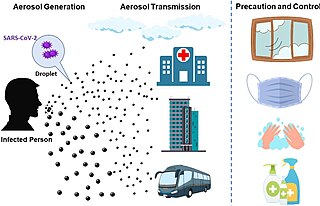Related Research Articles

The common cold or the cold is a viral infectious disease of the upper respiratory tract that primarily affects the respiratory mucosa of the nose, throat, sinuses, and larynx. Signs and symptoms may appear fewer than two days after exposure to the virus. These may include coughing, sore throat, runny nose, sneezing, headache, and fever. People usually recover in seven to ten days, but some symptoms may last up to three weeks. Occasionally, those with other health problems may develop pneumonia.

Avian influenza, also known as avian flu or bird flu, is a disease caused by the influenza A virus, which can infect both birds and people. It is similar to other types of animal flu in that it is caused by a virus strain that has adapted to a specific host. The type with the greatest risk is highly pathogenic avian influenza (HPAI).

Air travel is a form of travel in vehicles such as airplanes, jet aircraft, helicopters, hot air balloons, blimps, gliders, hang gliders, parachutes, or anything else that can sustain flight. Use of air travel began vastly increasing in the 1930s: the number of Americans flying went from about 6,000 in 1930 to 450,000 by 1934 and to 1.2 million by 1938. It has continued to greatly increase in recent decades, doubling worldwide between the mid-1980s and the year 2000. Modern air travel is much safer than road travel.

An asymptomatic carrier is a person or other organism that has become infected with a pathogen, but shows no signs or symptoms.
In medicine, public health, and biology, transmission is the passing of a pathogen causing communicable disease from an infected host individual or group to a particular individual or group, regardless of whether the other individual was previously infected. The term strictly refers to the transmission of microorganisms directly from one individual to another by one or more of the following means:

Oseltamivir, sold under the brand name Tamiflu, is an antiviral medication used to treat and prevent influenza A and influenza B, viruses that cause the flu. Many medical organizations recommend it in people who have complications or are at high risk of complications within 48 hours of first symptoms of infection. They recommend it to prevent infection in those at high risk, but not the general population. The Centers for Disease Control and Prevention (CDC) recommends that clinicians use their discretion to treat those at lower risk who present within 48 hours of first symptoms of infection. It is taken by mouth, either as a pill or liquid.

Flu season is an annually recurring time period characterized by the prevalence of an outbreak of influenza (flu). The season occurs during the cold half of the year in each hemisphere. It takes approximately two days to show symptoms. Influenza activity can sometimes be predicted and even tracked geographically. While the beginning of major flu activity in each season varies by location, in any specific location these minor epidemics usually take about three weeks to reach its pinnacle, and another three weeks to significantly diminish.

Transmission and infection of H5N1 from infected avian sources to humans has been a concern since the first documented case of human infection in 1997, due to the global spread of H5N1 that constitutes a pandemic threat.
An emergent virus is a virus that is either newly appeared, notably increasing in incidence/geographic range or has the potential to increase in the near future. Emergent viruses are a leading cause of emerging infectious diseases and raise public health challenges globally, given their potential to cause outbreaks of disease which can lead to epidemics and pandemics. As well as causing disease, emergent viruses can also have severe economic implications. Recent examples include the SARS-related coronaviruses, which have caused the 2002–2004 outbreak of SARS (SARS-CoV-1) and the 2019–2023 pandemic of COVID-19 (SARS-CoV-2). Other examples include the human immunodeficiency virus, which causes HIV/AIDS; the viruses responsible for Ebola; the H5N1 influenza virus responsible for avian influenza; and H1N1/09, which caused the 2009 swine flu pandemic. Viral emergence in humans is often a consequence of zoonosis, which involves a cross-species jump of a viral disease into humans from other animals. As zoonotic viruses exist in animal reservoirs, they are much more difficult to eradicate and can therefore establish persistent infections in human populations.

Influenza, commonly known as "the flu" or just "flu", is an infectious disease caused by influenza viruses. Symptoms range from mild to severe and often include fever, runny nose, sore throat, muscle pain, headache, coughing, and fatigue. These symptoms begin one to four days after exposure to the virus and last for about two to eight days. Diarrhea and vomiting can occur, particularly in children. Influenza may progress to pneumonia from the virus or a subsequent bacterial infection. Other complications include acute respiratory distress syndrome, meningitis, encephalitis, and worsening of pre-existing health problems such as asthma and cardiovascular disease.

The 2009 swine flu pandemic, caused by the H1N1/swine flu/influenza virus and declared by the World Health Organization (WHO) from June 2009 to August 2010, was the third recent flu pandemic involving the H1N1 virus. The first identified human case was in La Gloria, Mexico, a rural town in Veracruz. The virus appeared to be a new strain of H1N1 that resulted from a previous triple reassortment of bird, swine, and human flu viruses which further combined with a Eurasian pig flu virus, leading to the term "swine flu".

In public health, social distancing, also called physical distancing, is a set of non-pharmaceutical interventions or measures intended to prevent the spread of a contagious disease by maintaining a physical distance between people and reducing the number of times people come into close contact with each other. It usually involves keeping a certain distance from others and avoiding gathering together in large groups.

Airborne transmission or aerosol transmission is transmission of an infectious disease through small particles suspended in the air. Infectious diseases capable of airborne transmission include many of considerable importance both in human and veterinary medicine. The relevant infectious agent may be viruses, bacteria, or fungi, and they may be spread through breathing, talking, coughing, sneezing, raising of dust, spraying of liquids, flushing toilets, or any activities which generate aerosol particles or droplets.
Influenza prevention involves taking steps that one can use to decrease their chances of contracting flu viruses, such as the Pandemic H1N1/09 virus, responsible for the 2009 flu pandemic.

Infection in childcare is the spread of infection during childcare, typically because of contact among children in daycare or school. This happens when groups of children meet in a childcare environment, and there any individual with an infectious disease may spread it to the entire group. Commonly spread diseases include influenza-like illness and enteric illnesses, such as diarrhea among babies using diapers. It is uncertain how these diseases spread, but hand washing reduces some risk of transmission and increasing hygiene in other ways also reduces risk of infection.
A focus of infection is a place containing whatever epidemiological factors are needed for transmission of an infection. Any focus of infection will have a source of infection, and other common traits of such a place include a human community, a vector population, and environmental characteristics adequate for spreading infection.

Air China Flight 112 was a scheduled international passenger flight on 15 March 2003 that carried a 72-year-old man infected with severe acute respiratory syndrome (SARS). This man would later become the index passenger for the infection of another 20 passengers and two aircraft crew, resulting in the dissemination of SARS north to inner Mongolia and south to Thailand. The incident demonstrated how a single person could spread disease via air travel and was one of a number of superspreading events in the global spread of SARS in 2003. The speed of air travel and the multidirectional routes taken by affected passengers accelerated the spread of SARS with a consequential response from the World Health Organization (WHO), the aviation industry and the public.
Allison Joan McGeer is a Canadian infectious disease specialist in the Sinai Health System, and a professor in the Department of Laboratory Medicine and Pathobiology at the University of Toronto. She also appointed at the Dalla Lana School of Public Health and a Senior Clinician Scientist at the Lunenfeld-Tanenbaum Research Institute, and is a partner of the National Collaborating Centre for Infectious Diseases. McGeer has led investigations into the severe acute respiratory syndrome outbreak in Toronto and worked alongside Donald Low. During the COVID-19 pandemic, McGeer has studied how SARS-CoV-2 survives in the air and has served on several provincial committees advising aspects of the Government of Ontario's pandemic response.
In epidemiology, a non-pharmaceutical intervention (NPI) is any method used to reduce the spread of an epidemic disease without requiring pharmaceutical drug treatments. Examples of non-pharmaceutical interventions that reduce the spread of infectious diseases include wearing a face mask and staying away from sick people.

The transmission of COVID-19 is the passing of coronavirus disease 2019 from person to person. COVID-19 is mainly transmitted when people breathe in air contaminated by droplets/aerosols and small airborne particles containing the virus. Infected people exhale those particles as they breathe, talk, cough, sneeze, or sing. Transmission is more likely the closer people are. However, infection can occur over longer distances, particularly indoors.
References
- 1 2 Mangili A, Gendreau MA (2005). "Transmission of infectious diseases during commercial air travel". Lancet. 365 (9463): 989–96. doi:10.1016/S0140-6736(05)71089-8. PMC 7134995 . PMID 15767002.
- ↑ Leder K, Newman D (2005). "Respiratory infections during air travel". Intern Med J. 35 (1): 50–55. doi:10.1111/j.1445-5994.2004.00696.x. PMC 7165774 . PMID 15667469.
- ↑ Olsen SJ, Chang HL, Cheung TY, et al. (2003). "Transmission of the severe acute respiratory syndrome on aircraft". N Engl J Med. 349 (25): 2416–22. doi: 10.1056/NEJMoa031349 . PMID 14681507.
- ↑ Luna LK, Panning M, Grywna K, Pfefferle S, Drosten C (2007). "Spectrum of viruses and atypical bacteria in intercontinental air travelers with symptoms of acute respiratory infection". J Infect Dis. 195 (5): 675–9. doi: 10.1086/511432 . PMC 7199876 . PMID 17262708.
- ↑ Brownstein JS, Wolfe CJ, Mandl KD (2006). "Empirical evidence for the effect of airline travel on inter-regional influenza spread in the United States". PLOS Med. 3 (10): 3401. doi: 10.1371/journal.pmed.0030401 . PMC 1564183 . PMID 16968115.
- ↑ Pavia, Andrew T. (2007). "Germs on a Plane: Aircraft, International Travel, and the Global Spread of Disease". Journal of Infectious Diseases. 195 (5): 621–22. doi:10.1086/511439. PMC 7109684 . PMID 17262701.
- ↑ Globalization and infectious diseases: A review of the linkagesLance Saker,1MSc MRCPKelley Lee,1MPA, MA, D.Phil.Barbara Cannito,1MScAnna Gilmore,2MBBS, DTM&H, MSc, MFPHMDiarmid Campbell-Lendrum,1D.Phil. "Globalization and infectious diseases: A review of the linkages" (PDF). The WHO.
{{cite web}}: CS1 maint: multiple names: authors list (link) CS1 maint: numeric names: authors list (link) - ↑ Aron, Joan (2003). Ecosystem Change and Public Health | Johns Hopkins University Press Books. jhupbooks.press.jhu.edu. doi:10.56021/9780801865817. ISBN 9780801874581 . Retrieved 2020-04-14.
- 1 2 3 Marchitelli, Rosa (30 May 2016). "Air Canada passenger suffers 'horrible pain' after being stuck in cramped seat". CBC. Retrieved 30 May 2016.
- 1 2 Kuipers S, Cannegieter SC, Middeldorp S, Robyn L, Büller HR, Rosendaal FR (2007). "The absolute risk of venous thrombosis after air travel: a cohort study of 8,755 employees of international organisations". PLOS Med. 4 (9): e290. doi: 10.1371/journal.pmed.0040290 . PMC 1989755 . PMID 17896862.
- ↑ Evaluation of the Cosmic Ray Exposure of Aircraft Crew
- ↑ Phillips, Tony (25 October 2013). "The Effects of Space Weather on Aviation". Science News. NASA.
- ↑ "NAIRAS Real-time radiation Dose". sol.spacenvironment.net. Retrieved 1 June 2019.
- ↑ Protection of air crew from cosmic radiation: Guidance material
- ↑ Page 173 in: Genevieve Howland (2017). The Mama Natural Week-by-Week Guide to Pregnancy and Childbirth. Simon and Schuster. ISBN 9781501146688.
- 1 2 Page 57 in: Sarah Jarvis, Joanne Stone, Keith Eddleman, Mary Duenwald (2011). Pregnancy For Dummies. John Wiley & Sons. ISBN 9781119997061.
{{cite book}}: CS1 maint: multiple names: authors list (link)